Morgan
International Hazard
    
Posts: 1694
Registered: 28-12-2010
Member Is Offline
Mood: No Mood
|
|
Unfamiliar Microscope
I was given this microscope but I'm not familiar with it and what things might be interesting to look at under low magnification? The eyepieces say
WF10X which isn't very high. At first it seemed like a meager microscope but doing a cursory search it's valued for looking at larger things it seems.
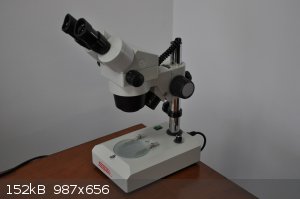
|
|
|
Tsjerk
International Hazard
    
Posts: 3032
Registered: 20-4-2005
Location: Netherlands
Member Is Offline
Mood: Mood
|
|
It is a binocular, which is indeed meant to look at larger objects.
|
|
|
Morgan
International Hazard
    
Posts: 1694
Registered: 28-12-2010
Member Is Offline
Mood: No Mood
|
|
I found this one which looks similar.
https://www.mscdirect.com/product/details/00254375
|
|
|
Sulaiman
International Hazard
    
Posts: 3695
Registered: 8-2-2015
Location: 3rd rock from the sun
Member Is Offline
|
|
The 10x refers only to the eyepiece power,
Overall magnification is (eyepiece power) x (objective power)
But yes, stereo microscopes are usually lower power than monocular types.
CAUTION : Hobby Chemist, not Professional or even Amateur
|
|
|
yobbo II
National Hazard
   
Posts: 762
Registered: 28-3-2016
Member Is Offline
Mood: No Mood
|
|
Is there two objectives on the bottom of the scope (turn it up).
Yob
|
|
|
Morgan
International Hazard
    
Posts: 1694
Registered: 28-12-2010
Member Is Offline
Mood: No Mood
|
|
I read the WF10x marks on the eyepieces designate wide field. On the knob below the eyepieces there're the same gradation numbers going from 4.5 to
0.65 on my microscope so it looks like 45x would be the maximum magnification as stated on this specification chart below the image.
https://www.mscdirect.com/product/details/00254375
I didn't see any eyepieces for it above 15x.
https://www.2spi.com/item/09878-ab/stereo-microscopes/
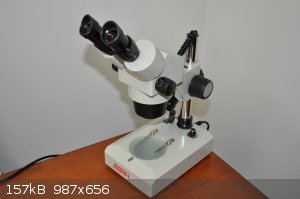
[Edited on 17-11-2022 by Morgan]
|
|
|
numos
Hazard to Others
  
Posts: 269
Registered: 22-2-2014
Location: Pasadena
Member Is Offline
Mood: No Mood
|
|
We used to use microscopes like this for looking at crystals to see if they were viable for crystallography. They are nice because you can walk up to
it, stick a vial under there, rotate it, and get a good look at crystals in a short time.
|
|
|
Morgan
International Hazard
    
Posts: 1694
Registered: 28-12-2010
Member Is Offline
Mood: No Mood
|
|
Some magnification tidbits ...
Adam Savage's Favorite Tools: Wearable Magnifiers!
https://youtu.be/96ZIry7YG7U
These articulating boom stands are kind of interesting if you had the need.
https://www.penntoolco.com/spi-stereo-microscope-on-a-boom-s...
|
|
|
Twospoons
International Hazard
    
Posts: 1324
Registered: 26-7-2004
Location: Middle Earth
Member Is Offline
Mood: A trace of hope...
|
|
Thats the type I use all the time in PCB inspection and soldering, though I have a ring light around the objective. I have x10 and x20 eyepieces, as
well as x2 and x0.5 barlow lenses which screw on below the objective. Having a x0.5 Barlow may seem odd ( it cuts magnification in half), but what
you get in exchange is a much greater working distance, which is very useful for getting tools under the microscope.
Helicopter: "helico" -> spiral, "pter" -> with wings
|
|
|
Morgan
International Hazard
    
Posts: 1694
Registered: 28-12-2010
Member Is Offline
Mood: No Mood
|
|
Quote: Originally posted by Twospoons  | | Thats the type I use all the time in PCB inspection and soldering, though I have a ring light around the objective. I have x10 and x20 eyepieces, as
well as x2 and x0.5 barlow lenses which screw on below the objective. Having a x0.5 Barlow may seem odd ( it cuts magnification in half), but what
you get in exchange is a much greater working distance, which is very useful for getting tools under the microscope. |
That's interesting how one big lens screws on below the objectives as an auxiliary objective and doubles the working distance and field of view of the
microscope. Thanks for "enlarging" my understanding and potential uses of such a microscope.
I found this 0.5 Barlow lens discussion informative starting a little after the 3 minute mark.
What are Barlow Lenses? All you ever wanted to know | Amateur Microscopy
https://youtu.be/Vr2bHdmGdiA
|
|
|
j_sum1
Administrator
       
Posts: 6320
Registered: 4-10-2014
Location: At home
Member Is Offline
Mood: Most of the ducks are in a row
|
|
These are used in biology for dissection and looking at things like insects and flowers.
They are lower magnification but have higher depth of field. That combined with the stereo image gives good three dimensional viewing.
If you look closely at the objective lens you will find that it is actually two lenses: providing two separate images for stereo viewing.
|
|
|
Morgan
International Hazard
    
Posts: 1694
Registered: 28-12-2010
Member Is Offline
Mood: No Mood
|
|
The first thing I did when I got the microscope was unscrew the housing or cowling around the objectives to see how it was designed. The deep spiral
grooves in the brass must have a function but they don't interact with any external gear or anything when turning the knob to focus something. They
just twirl independently driven by the plastic gears above. Apparently there's some internal goings on because there is no apparent raising or
lowering of the objectives when turning the 0.65 to 4.5 knob.
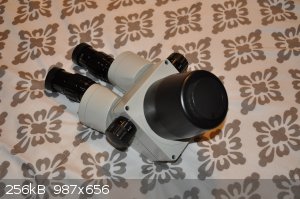 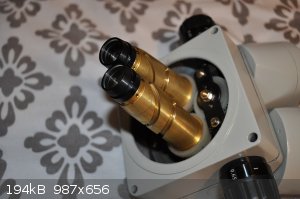 
[Edited on 18-11-2022 by Morgan]
|
|
|
Morgan
International Hazard
    
Posts: 1694
Registered: 28-12-2010
Member Is Offline
Mood: No Mood
|
|
Quote: Originally posted by j_sum1  | These are used in biology for dissection and looking at things like insects and flowers.
They are lower magnification but have higher depth of field. That combined with the stereo image gives good three dimensional viewing.
If you look closely at the objective lens you will find that it is actually two lenses: providing two separate images for stereo viewing.
|
I found a dead tiger beetle with this coloration in my garage and looked at it under the stereo microscope. The iridescent parts were quite vivid.
Wish I had a camera adapter for the scope to take pictures. One site said they are among the fastest insects walking 5.6 mph.
https://www.opsu.edu/Academics/SciMathNurs/NaturalScience/Pl...
https://www.flickr.com/photos/drphotomoto/3691754855
https://bugguide.net/node/view/61573
|
|
|
Twospoons
International Hazard
    
Posts: 1324
Registered: 26-7-2004
Location: Middle Earth
Member Is Offline
Mood: A trace of hope...
|
|
It is possible to take pictures through a microscope using a phone camera, but it requires a very steady hand, and very careful placement of the phone
camera above the eyepiece.
The grooves will be part of the zoom mechanism, and will be moving some internal elements of the objectives.
Helicopter: "helico" -> spiral, "pter" -> with wings
|
|
|
Morgan
International Hazard
    
Posts: 1694
Registered: 28-12-2010
Member Is Offline
Mood: No Mood
|
|
Quote: Originally posted by Twospoons  | It is possible to take pictures through a microscope using a phone camera, but it requires a very steady hand, and very careful placement of the phone
camera above the eyepiece.
The grooves will be part of the zoom mechanism, and will be moving some internal elements of the objectives. |
I gave it a shot with my phone but wow it is exceedingly tricky to hold the phone still over the correct spot above the eyepiece, the slightest
movement and the whole image disappears. This was but a meager quick test with a tiger beetle however it's interesting that you can use a phone.
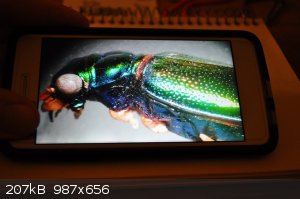
[Edited on 19-11-2022 by Morgan]
|
|
|
Morgan
International Hazard
    
Posts: 1694
Registered: 28-12-2010
Member Is Offline
Mood: No Mood
|
|
I saw at the 22:30 mark he talks about a stereo microscope and shows a nifty phone attachment of some sort connected to one of the two eyepieces.
https://youtu.be/zKUYf4QLh1s
|
|
|